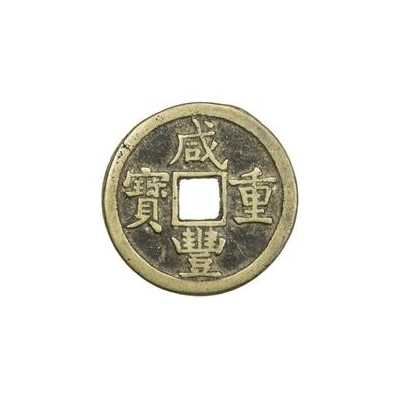


© Stephen Album Rare Coins
5 Cash - Xianfeng Zhongbao; Boo-yuwan; large type ND
| Brass | 7.78 g | 32 mm |
| Issuer | Empire of China |
|---|---|
| Emperor | Qing dynasty › Xianfeng (咸豐帝) (1850-1861) |
| Type | Standard circulation coin |
| Years | 1854-1857 |
| Value | 5 Cash |
| Currency | Cash (621-1912) |
| Composition | Brass |
| Weight | 7.78 g |
| Diameter | 32 mm |
| Shape | Round with a square hole |
| Technique | Cast |
| Orientation | Medal alignment ↑↑ |
| Demonetized | Yes |
| Updated | 2024-10-04 |
| Numista | N#44264 |
|---|---|
| Rarity index | 84% |
Reverse
Two Manchu words (read vertically) separated by the hole, all with one Chinese ideogram above and one below.
Scripts: Chinese (traditional, regular script), Mongolian / Manchu
Lettering:
當
ᠪᠣᠣ ᠶᡠᠸᠠᠨ
五
Translation:
Dang Wu / Boo-chiowan
Value 5 / Boo-chiowan
Edge
Plain
Comment
This denomination was first introduced in April 1854, being 60% copper. Their casting was stopped in September 1857, and they no longer circulated.DocBeiStrokes
Interesting fact
One interesting fact about the Xianfeng Zhongbao (Boo-yuwan) coin is that it was produced during a time of significant economic and political change in China. The Xianfeng Emperor, who ruled from 1850 to 1861, implemented a number of reforms aimed at modernizing China's economy and government, including the introduction of new currency systems. The large-type 5 Cash coin, which was introduced in 1854, was part of these reforms and was designed to replace the earlier small-type coins. Despite the changes, the coin still maintained the traditional design of a square hole in the center and a rim with Chinese characters. This coin is a unique example of how China's ancient currency systems were adapting to the changing needs of the country during the 19th century.

